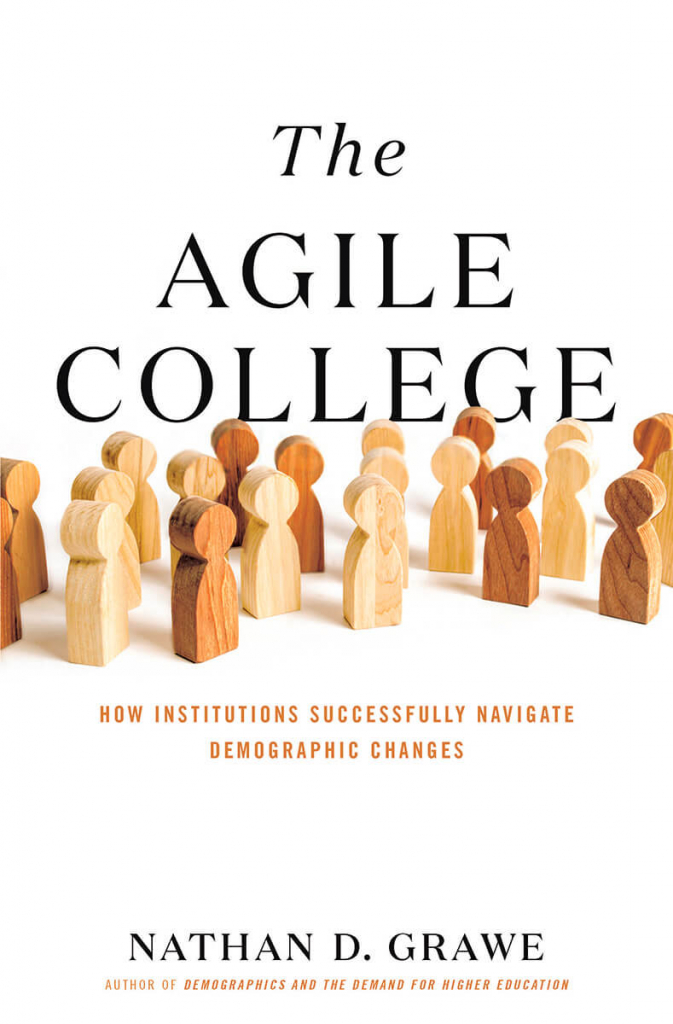
Dr. Nathan Grawe, Author of “The Agile College”
Dr. Nathan Grawe is the Ada M. Harrison Distinguished Teaching Professor of the Social Sciences and Professor of Economics at Carleton College. He is a labor economist whose work examines intergenerational connections in education and labor market outcomes. His book, “Demographics and The Demand for Higher Education” examines how recent demographic shifts are likely to affect demand for higher education. In a follow-up project published in 2021, “The Agile College,” Grawe draws on interviews with higher education leaders to provide examples of how proactive institutions are grappling with demographic change.
“The Agile College” explores how proactive institutions are preparing for the resulting challenges that lie ahead. While it isn’t possible to reverse the demographic tide, most institutions, Grawe argues, can mitigate the effects. We asked Grawe to share some insights on the current environment and what advice he has for higher education marketers.
Can you give us a snapshot of the demographics within the college landscape?
There are two relevant kinds of changes: shifts in the composition of young people and changes in the number of young people in each cohort. Regarding the former, William Frey estimates the year in which the U.S. population ceases to be majority non-Hispanic white. For the country as a whole, he estimates 2045. But younger populations are more ethnically diverse; for those under age 18, we passed the milestone last year. We see this change on college campuses. The Department of Education reports that over 70% of post-secondary enrollees were White in 2000; by 2019 this share was just 54%. We also see increases in the share of young people who have at least one parent with a bachelor’s degree (BA).
While colleges grapple with a changing composition, they anticipate shrinking pools of prospective students. The number of births has steadily fallen since the onset of the Great Recession in 2008. Through 2020, we saw a reduction of 17%. So, for institutions serving traditional-aged students, we can anticipate a long and deep reduction in pool size beginning in 2026.
“There are two relevant kinds of changes: shifts in the composition of young people and changes in the number of young people in each cohort.”
How do you expect the demographic changes to reshape the market for higher education?
Because the access agenda has been very successful, about 2/3 of high school graduates go directly on to postsecondary enrollment the following fall. With such a high matriculation rate, it’s really hard for there to be a change in the population size of the magnitude just described without seeing a similar-sized change in college enrollments. So, for most institutions, we can anticipate reduced demand (at least if we continue to make the same choices we’ve made in the past). Based on past college-going choices of young people, the most selective institutions will benefit from the rising number of young people who have a parent with a BA. So, the most selective schools might be expected to see increased demand. But for higher ed as a whole, without changes in college-going behaviors, we need to get ready for lower enrollments.
One way to avoid this unpleasant future would be to figure out how to generate more enrollments from a given number of young people. This points us to the importance of retention improvements. For better or worse, retention data for higher education as a whole show that we could offset much of the decline in births by increasing retention and student success.

What are some of the best practices schools can use for retention in this new world?
Context matters so much; it’s not clear that there is a single answer. But there are some principles that come up over and over including: Recognize that retention is a multi-faceted problem with financial, academic, and social aspects; when recruiting new student groups, consider the myriad ways that those students’ new skills and needs intersect with your campus, and ask how the institution must adapt to serve these new students; remember that students are individuals, which means advising and student support needs to be individualized (even if sometimes individualized service involves technology and automated systems); and every employee who interacts with students is part of the institution’s “re-enrollment office,” so we need to generate broad ownership of the problem.
“Retention data for higher education as a whole show that we could offset much of the decline in births by increasing retention and student success.”

How do you tie all of this into an institutional growth plan?
It’s far too easy to create budgets backwards—start with expenditures you want and then sort out how many students you’ll need to recruit. From WWII through 2014, we experienced decades of fast-paced enrollment growth. In those years, backward budgeting might have worked. But since 2014, each year has seen fewer enrollments than the year before. Such environments demand greater rigor. Given projections of high school graduates from WICHE, what is a reasonable expectation for new enrollment growth? How might our retention work provide relief from declining numbers of new students? Those seem like important places to start budget discussions.
Given the importance of retention in the present environment, I’d also ask “what’s our number?” That is, if we were to increase retention by one percentage point, how much more revenue might we expect to generate? When I speak with leaders who have this number at the top of their head, I find they are also more inclined to think creatively and aggressively about initiatives to improve student success.